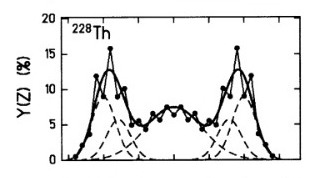Hi everyone!!
I’m currently attempting to fit a graph using 5 Gaussian functions. While I’ve successfully fitted the graph with three Gaussian functions, I’m looking to achieve a fit with five Gaussians, as shown in the below figure.

Below I have attached the code but it’s not yielding the desired outcome.
five_gaus.C (2.3 KB)
Here’s the code for fitting with 3 gaussians which is working perfectly.
> void three_gaus()
> {
>
> TCanvas *c1 = new TCanvas();
>
> Double_t x[29] = { 33.83562, 35.75342, 37.94521, 39.58904, 41.78082, 43.42466, 45.34247, 47.26027, 49.17808,51.09589, 53.28767, 55.20548, 56.84932, 59.0411, 60.9589, 62.60274, 64.79452, 66.71233, 68.63014, 70.54795, 72.46575,74.38356, 76.30137, 78.21918, 80.13699, 82.05479, 83.9726, 85.89041, 87.80822 };
> Double_t y[29] = { 0.4141745, 2.099813, 3.643964, 11.80912, 8.987073, 15.74378, 8.837867, 10.10097, 4.885202,5.584925, 4.312174, 6.561194, 5.571419, 7.39726, 6.265998, 7.3889, 5.552769, 6.534182, 4.276159, 5.539263, 4.971381, 10.0373, 8.906039, 15.6621, 8.897035, 11.70943, 3.676764, 2.122966, 0.4283234 };
>
> TGraph *graph = new TGraph(29, x, y);
> graph->SetMarkerStyle(8);
> graph->Draw("APL");
>
> TF1 *fit1 = new TF1("fit1", "gaus");
> fit1->SetLineColor(kMagenta);
> fit1->SetLineStyle(2);
>
> TF1 *fit2 = new TF1("fit2", "gaus");
> fit2->SetLineColor(kGreen);
> fit2->SetLineStyle(2);
>
> TF1 *fit3 = new TF1("fit3", "gaus");
> fit3->SetLineColor(kMagenta);
> fit3->SetLineStyle(2);
>
> TF1 *total = new TF1("total", "gaus(0)+gaus(3)+gaus(6)", 0, 90);
> total->SetLineColor(kBlue);
> total->SetParameters(16, 45, 2, 8, 60, 3, 16, 80, 2);
> graph->Fit(total, "R+");
>
> for (int i = 0; i < 3; ++i)
> {
> fit1->SetParameter(i, total->GetParameter(i));
> fit2->SetParameter(i, total->GetParameter(i + 3));
> fit3->SetParameter(i, total->GetParameter(i + 6));
> }
>
> fit1->SetRange(0,90);
> fit1->Draw("same");
> fit2->SetRange(0,90);
> fit2->Draw("same");
> fit3->SetRange(0,90);
> fit3->Draw("same");
>
> }
I’d greatly appreciate any guidance or assistance in modifying the code to achieve a successful fit with five Gaussian functions. Thank you in advance for your help!